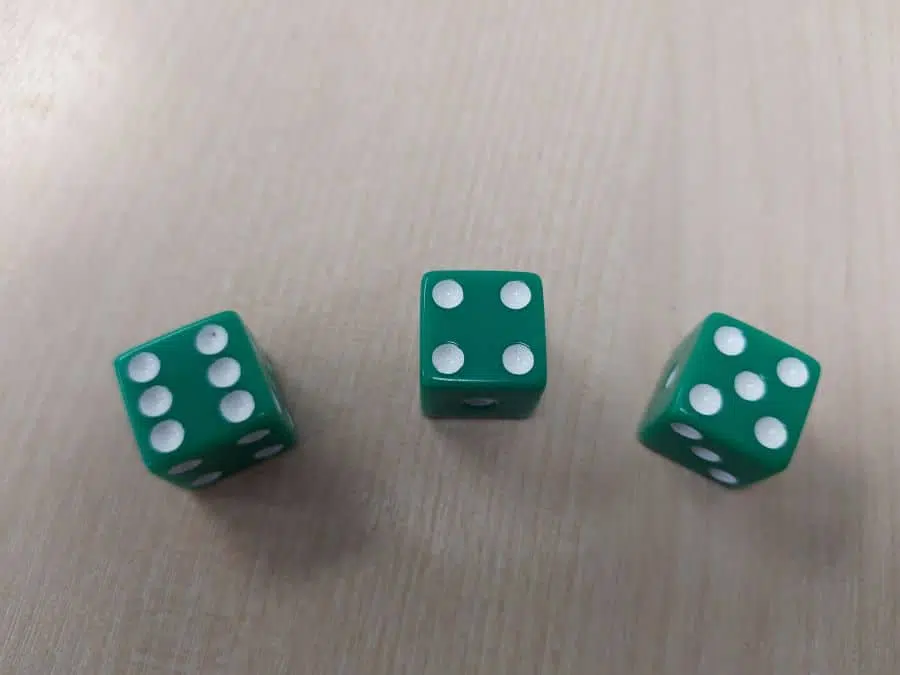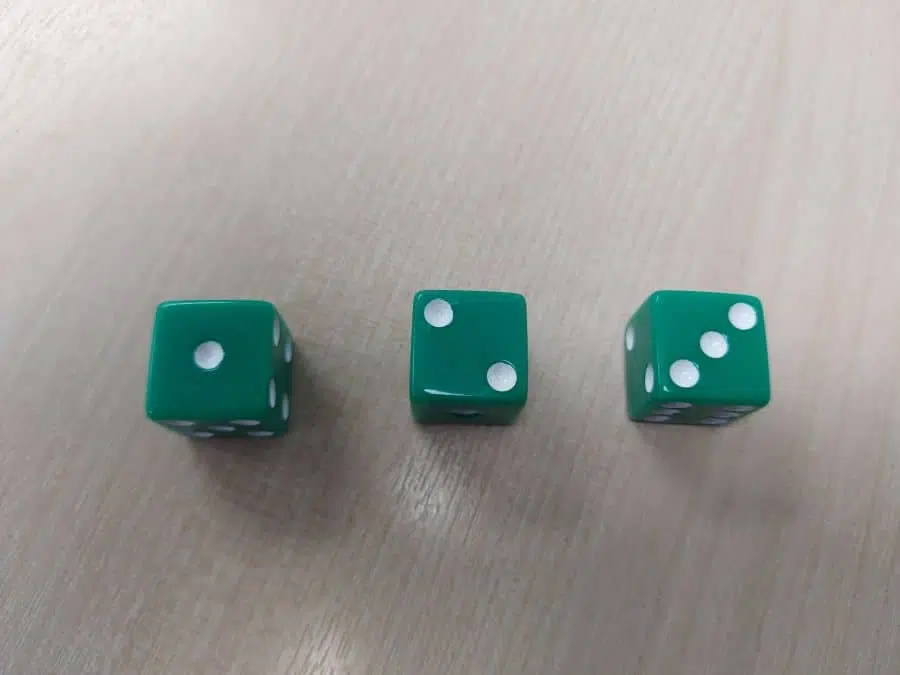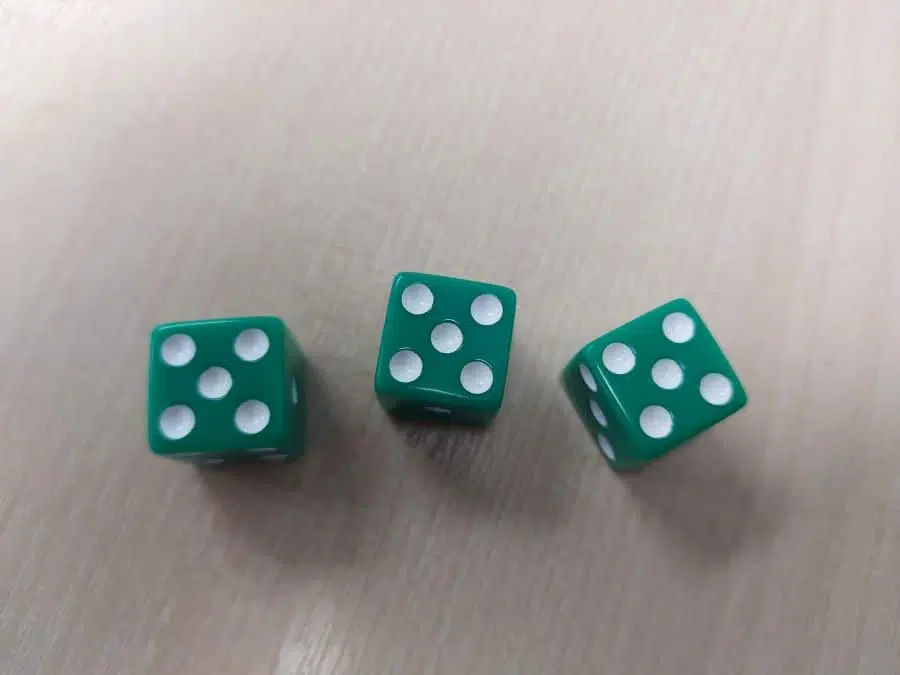There are loads of fantastic games for 3 dice that can be played by young and old alike.
As a teacher of more than a decade, and a father of three, I have played lots of these games with my own kids at home.
For all of these games, you only really need three dice each (plus the odd piece of paper and pencil to keep score with).
My favorite 11 dice games for 3 dice are:
- Going to Boston
- Pair Race
- 1,2,3
- Higher Lower
- Cee-lo
- Dice War
- Knock-Out
- Target Number
- First To 3
- 50 Up
- Double Thief!
All of these are extremely budget-friendly. So, let’s dive into the ultimate 11 dice games with 3 dice:

1. Going To Boston
Resources – 3 dice each, a piece of paper, and pencil
Players – 2-4
This is a pretty well-known dice game, that is just as great for adults or kids. I’ve played this one with my own kids to help them practice adding and counting.
Each player has three dice to start with. You can use three dice between you and share if you prefer. (This is the caring sharing kind of way to do it).
One player goes first (usually the youngest).
They roll three dice. Take out the highest number. Roll the remaining two dice, take out the highest number again, and then roll the last dice one more time.
Then you add up your score.
So, as an example, you might roll 3, 2, and 5. Take out the 5. Then you roll the lower two dice.
You get 1 and 4. Take out the 4.
Lastly, you roll a 3. So your score is 5, 4, and 3. Add them up to get 12.
Write down 12 on the scoresheet.
Then the next person goes. Keep on adding up your scores as you go through the rounds.
Before you play, agree on how many rounds you are going to have. We normally have ten.
At the end of ten rounds, the winner is the person with the highest score. If you’re still not sure how to play, then check out this youtube video:
2. Pair Race
Resources – 3 dice per player, one piece of paper and pen per person
Players – 2-10
This is a game of speed.
Someone says, ‘Go!’ Then everyone starts rolling their dice as fast as possible. Every time you roll a pair you get one point. Make a note of your point on a piece of paper.
Then keep rolling.
The winner is the first person to get to ten.
You can also play this game with an independent scorer watching, and attributing scores as you go.
3. 1,2,3
Resources – 3 dice per player
Players – 2-10
This game is another pretty speedy race.
To start with, one player says, ‘Go!’ The aim then is to get the numbers 1, 2, and 3 to show on the dice.
Roll the three dice, and if any of those numbers (1, 2, or 3) are showing, then just leave those dice where they are.
Roll the other dice, and keep on rolling until you get the numbers 1, 2, and 3. The first player to get to this point is the winner.

4. Higher Lower
Resources – 3 dice per player
Players 2
This is like the classic card game ‘higher or lower’ which you might have seen on TV gameshows.
Each player has three dice, to begin with. The youngest player goes first. That person rolls one dice.
The other person must then call ‘higher’ or ‘lower’. Then they roll their dice.
If the second player is correct, then they win the two dice. If they are incorrect, then the first player wins the two dice.
So, as an example, player 1 rolls a 3. Player 2 calls ‘higher’. They roll a 5. They are correct (the number is higher), and so they win the two dice.
On the other hand, if player 2 had rolled a 1 after calling ‘higher’, they would be incorrect, and so player 1 would win both dice.
Whoever wins both dice goes first in the next round.
The one exception in the game is if someone rolls the same number as the first to be rolled. So if player 1 rolls a 3, and then player 2 rolls a 3 (as an example), then that is a draw.
What happens then? Well, I play the version where the roles are reversed, and it is now player one’s turn to call in this round.
So, as a demo, player 1 rolls a 2. Player 2 calls ‘higher’, but rolls a 2 as well. Then it is player 1s turn to call. They call, ‘Higher’. Player 2 rolls a 4, so player 1 wins the dice. I hope this makes sense!
Keep playing the game until one player has won all the dice.
5. Cee-lo
Resources – 3 dice each
Players – 2-6
This is probably the best-known 3-dice game out there.
Basically, each player has three dice (or shares the same three dice for the game). One player goes first. They roll three dice.
If you get a pair, you take it out. The dice you are left with is then your score.
If you don’t get a pair the first time, then just keep on rolling until you get one.
Then the next person goes.
Roll your dice until you get a pair. Take the pair out, and your other dice is your score.
There are several scores that mean you either automatically win the round, or automatically lose the round. These are:
To win the round
Roll three of a kind
Roll 4, 5, 6
Roll a pair and a 6
To lose the round
Roll a 1, 2, 3
Roll a pair and a 1
Play round by round, players either winning by having the highest single dice score (when the pair is removed), or by winning the round automatically.
6. Dice War
Resources – 3 dice per player
Players – 2-6
Dice war is a really classic game for all ages. You can play with more than 3 dice (we often play with 6 or 10 dice).
But 3 dice work well and means the game is faster, and will probably be over quicker.
Each player starts with three dice. Each player rolls just one dice at the same time as the others.
The highest number on a dice is the winner of the round. The person that rolled the highest score, gets to keep all the dice.
Then roll again for round two, and repeat the process.
If there is a draw in a round (i.e. two or more numbers are the highest), then that round is a draw. Everyone collects their dice and simply rolls again. You have to have a straight winner in every round.
The winner is either:
- The person with the most dice after an agreed time limit (such as five minutes)
- The person that ends up collecting all the dice
7. Knock-Out
Resources – Three dice per player
Number of players – 2-6
In this game, you first agree on the ‘knock-out’ number.
To do this, each player rolls one dice. The highest number wins. That person then rolls their dice again, and whatever score they get – that is the ‘knock-out’ number.
Everyone starts with three dice. One at a time, a player rolls a dice. If they roll any dice that is not the knock-out number, then they are fine. They are safe and take back their dice.
However, if they roll the ‘knock-out’ number, then that dice is ‘knocked-out’. They put it in the middle of the table, and they are down to two.
Then the game continues.
When players lose all three dice, then they are ‘knocked out’.
The winner is the last player standing.
8. Target Number
Resources – Three dice per player
Players – 4-6
This game is similar to the ‘knock-out’ number game, but kind of in reverse.
First, decide what is going to be the ‘target’ number. Each player rolls one dice, and the highest is the winner. That person then rolls their dice again, and whatever number they get is the ‘target’ number.
Sit is a circle. One at a time, a player will roll one of their three dice. This time, you leave each dice in the middle of the circle.
If anyone rolls the ‘target’ number, then they win all of the dice on the table.
You are out of the game whenever you have rolled your last dice without getting the ‘target’ number.
The winner is the person at the end who either:
- Has the most dice after an agreed time limit
- Or wins all of the dice
9. First to 3!
Resources – 3 dice each
Players – 2-10
This is another game that is a race. Someone will say, ‘Go!’ The aim then is for the players to rapidly start rolling their dice.
If you get a pair when you roll, then keep that where it is, then you are going to be rolling the single dice until you get three of a kind.
If you don’t get a pair on the first roll, just keep rolling until you do.
The aim of this high-speed game is to be the first person that gets to have three of a kind.

10. 50 Up
Resources – 3 dice each, a pencil and piece of paper to keep score
Players – 2-10
Each player starts with three dice. Everyone rolls their dice at the same each round.
The idea is to roll a score that is worth a points total. The winning points total means that player is the winner of the round. They get their score from that round added to their score.
You get points for the following:
A pair – get the total of the pair put together. So 2 and 2 would be 4.
Three of a kind – Get 12, plus the three of a kind added together. So if you got 3, 3, 3, then you would get 12 + 3 + 3 + 3= 21.
A run of 3 consecutive dice – Add the total together and double it. So 3, 4, 5, would be 3 + 4 + 5 = 12. Times 2, equals 24.
If no one gets a scoring roll in each round, then just roll again.
Only the winner of each round has their score recorded. The winner of the whole game is the person that gets to 50.
11. Double Thief!
Resources – 3 dice each
Players – 2
One player rolls their three dice first. Then the other player rolls their dice.
If player 2 rolls any numbers that are the same as player 1, then player 2 gets to steal those dice!
Then, for round 2, player 2 rolls all the dice they now have. Player 1 will then roll their dice, and steal back.
Keep going like this, alternating between rolling first or second each round.
Every round, each player rolls all the dice that they have.
The winner is the first person to collect all of the dice.
